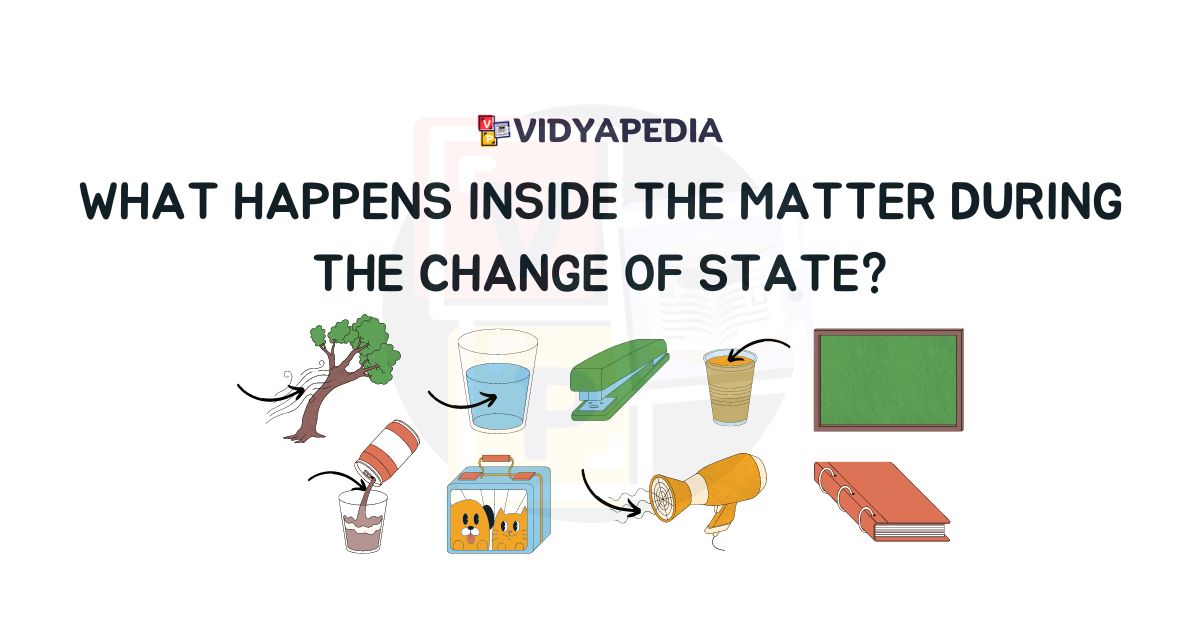During a change of state, the internal structure and behaviour of particles within matter undergo significant alterations. Here’s a detailed explanation of what happens inside matter during each change of state:
Certainly! Here’s the information presented in a more simplified and student-friendly language:
| Change of State | What Happens with Temperature? | What Happens to the Particles? | What Happens Between Particles? | What Actually Happens? |
|---|---|---|---|---|
| Melting (Solid to Liquid) | Temperature goes up | Particles start moving faster and vibrating more | The forces holding particles in place weaken | The solid starts to melt into a liquid |
| Freezing (Liquid to Solid) | temperature goes down | Particles start moving slower and become more orderly | The forces between particles become stronger | The liquid turns into a solid |
| Evaporation (Liquid to Gas) | Temperature goes up | Some particles near the surface get really speedy and break free | The forces holding the liquid together weaken, especially at the surface | The liquid turns into a gas |
| Condensation (Gas to Liquid) | temperature goes down | Gas particles slow down and start to clump together | The forces between gas particles pull them together into clusters | The gas changes into a liquid as it condenses |
| Sublimation (Solid to Gas) | temperature goes up | Solid particles get so much energy that they skip the liquid phase and jump into the air | Solid particles turn directly into gas without becoming liquid | The solid changes into a gas |
| Deposition (Gas to Solid) | temperature goes down | Gas particles slow down and stick together | The forces between gas particles become strong enough to pull them together into a solid structure | The gas changes into a solid |
Related Topic: Changes In State Of Matter
Here’s a simplified version of what happens inside matter during changes of state, explained in human language:
What happens inside the matter during the change of state? on Physics Level:
| Change of State | Description |
|---|---|
| Solid to Liquid | When something solid gets heated up, it starts shaking more and eventually turns into a liquid. Think of ice melting into water when it’s warm. |
| Liquid to Gas | If you heat up a liquid, it starts moving around faster and turns into a gas. Just like water boiling and turning into steam when you heat it. |
| Gas to Liquid | When a gas cools down, its particles slow down and come closer together, forming a liquid. Imagine steam from a hot shower turning back into water droplets when it touches a cool surface. |
| Liquid to Solid | If you cool down a liquid, its particles slow down even more and get closer together until they form a solid. This is like water freezing into ice in the freezer. |
What happens inside the matter during the change of state? on Chemistry Level:
| Change of State | Description |
|---|---|
| Melting | When a solid substance is heated, it starts to melt and become liquid. Picture chocolate melting in your hand on a warm day. |
| Freezing | Cooling down a liquid makes it lose its fluidity and turn into a solid. It’s like water turning into ice cubes in the freezer. |
| Evaporation | Liquid turning into a gas happens when the liquid gets warm enough and its particles escape into the air. It’s similar to water evaporating from a puddle on a sunny day. |
| Condensation | Gas turning back into a liquid occurs when it cools down and its particles slow down enough to stick together. Think of steam from boiling water turning back into water droplets on a cold window. |
| Sublimation | Some solids can turn directly into a gas without becoming liquid first. Dry ice is a good example – it goes straight from solid to gas without melting. |
| Deposition | Gas can also turn directly into a solid without becoming a liquid first. Frost forming on a cold surface is a common example of this. |
What happens inside the matter during the change of state? on a biological level:
| Change of State | Description |
|---|---|
| Solid to Liquid | In living organisms, changes in temperature can affect the consistency of things inside cells, like fats or proteins, making them more liquid-like. |
| Liquid to Gas | In biology, liquids turning into gases happen during processes like breathing, where liquid water in our bodies evaporates into the air we exhale. |
| Gas to Liquid | Condensation, or gas turning into liquid, can happen inside our bodies when warm air meets cooler surfaces, like when we breathe out on a cold day. |
| Liquid to Solid | Freezing of liquids can happen in biological systems, like when water freezes inside cells or on the surface of tissues, affecting their structure and function. |


